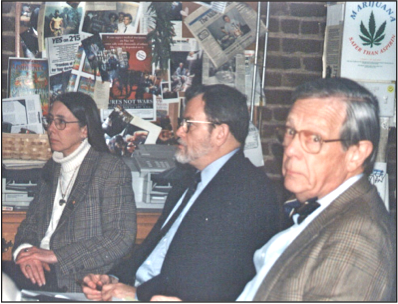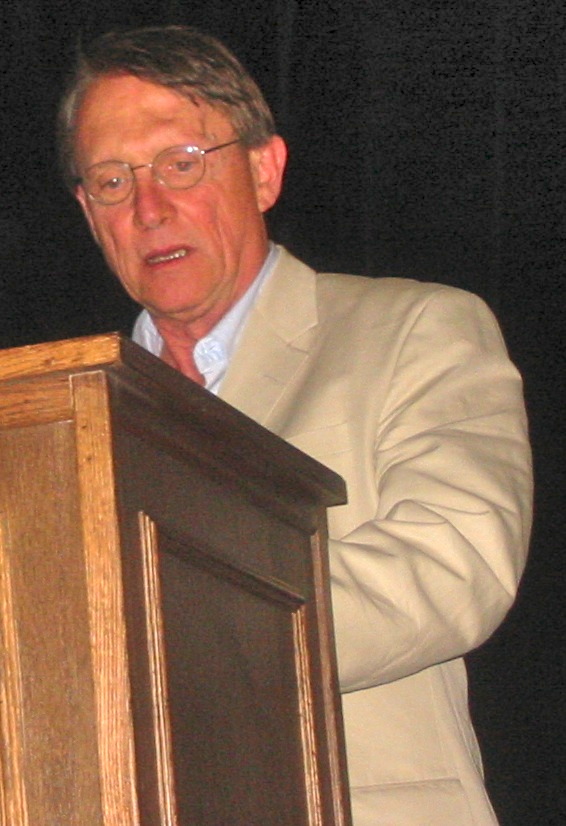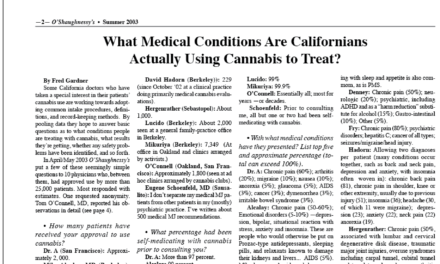Steve Robinson, MD, mentioned that many of his patients were living in isolation, without the support of family and friends. I asked if he had read Dennis Peron’s statement to the Institute of Medicine touching on this subject. He said no and I said I’d send it… This article first ran in December, 1997, in a xeroxed leaflet distributed at the San Francisco Cannabis Buyers’ Club and by Dr. Tod Mikuriya at his office.
The front-page headlines declared “Marijuana Clubs Illegal” as investigators from the Institute of Medicine arrived in San Francisco Dec. 12 to collect data and study the operations of three such clubs. The Institute of Medicine is a branch of the National Academy of Sciences, an organization founded by President Abraham Lincoln in 1860 to give the federal government objective advice on scientific questions.
The funding for the IOM study comes from Barry McCaffrey, director of the National Office on Drug Control Policy —and not because the 4-star general is getting open-minded late in life. This study is being conducted because in passing Prop 215 the people of California asserted our understanding that marijuana’s therapeutic effects outweigh whatever supposed negative effects have made it illegal all these years. McCaffrey gave the Institute of Medicine $1 million to conduct an 18-month study and file a report on the medical potential of marijuana and —of course— “the potential for addiction and progression to other medications,” the harmful effects of smoking, etc. Dreamy reformers hope the study will lead to a report that convinces the federal government to reschedule marijuana so that doctors can prescribe it.
The IOM study is being conducted by two male MD “investigators” and three female “staff.” The investigators are Stanley J. Watson, Jr. a mild-mannered research psychiatrist from the University of Michigan, and John A. Benson, Jr., a silver-haired, bow-tie-wearing professor emeritus who looks and sounds like he’s been sent by Central Casting but is actually from Oregon Health Sciences University.
Prior to their arrival in San Francisco, the investigators had sent the clubs an elaborate questionnaire asking all the logical questions: “What are the client profiles (age, gender, race, etc.)?” “What symptoms/illnesseses are clients seeking to treat with marijuana?” “How effective is marijuana at alleviating each symptom?” etc., etc. It included an acknowledgment that “cannabis buyers clubs are significant sources of information on the use of marijuana as a treatment for certain symptoms and diseases.”
The first visit was to CHAMP, the 600-member club at Church and Market (which has subsequently closed). Proprietor Vic Hernandez reports that there were 100 members present, it being Friday evening, and the place was buzzing with news of the court ruling and concern that Lungren would soon try to close down the clubs. The investigators were given data in the form of some 35 first-person accounts, written by members, describing their marijuana use and its effects. Three growers came, too -one with samples and some observations about how each strain affects particular conditions.
“We really pushed the idea of the clubs being an intermediary between patients and acute care -a harm reduction health center that helps people understand their medication and how to use it,” says Hernandez, who characterized the investigators as “respectful and sincere.”
The Oakland club, which the IOM crew visited Saturday morning, also took the occasion very seriously. The club’s 10-member research group had met Dec. 5 to discuss the preliminary questionnaire. Jerry Mandel then spent a week preparing a detailed response, based on a review of 1,500 members’ files.
“The passage of Prop 215 has made clinical research possible once again,” Tod Mikuriya told the investigators. Mikuriya is the club’s medical director -a 64-year old Berkeley psychiatrist who has devoted much of his career to studying cannabis. In 1967 he signed on to conduct the first-ever marijuana study for the National Institute of Mental Health; he left when ordered to look only for harmful effects.Mikuriya described the club’s intake form, which defines illnesses according to conventional ICD-9 codes, and the effort to gather information about individuals’ use patterns and the impact on their illnesses. “The biggest problem is disabusing people inside the Beltway,” said Dr. Tod. “They really don’t have any way of perceiving different kinds of social institutions and community activities going on out here except from sound bites and media presentations. We’re really pleased that we can directly communicate with you.”
IOM staffer Constance Pechura sought to reassure everyone that the investigators were independent from their funding source -the Drug Czar’s office- and were sincerely reviewing what scientists know about cannabis. “We’re not Beltway bandits,” she added, refering to the corrupt consultants who, for a fee, always produce the results their clients want. She said their report would “suggest what a research agenda should look like” and would not be vetted by McCaffrey’s office before being made public. Pechura said that “a major foundation” had also requested a review of what scientists know about marijuana and what a research agenda should include. She wouldn’t say which one.
Mandel, an experienced researcher with a PhD, laid out his preliminary findings -exactly the data the investigators had asked for. As of early December the Oakland club had registered some 1,500 members and sold cannabis to 1,084. There were 812 “core” members (four or more purchases) and 272 “occasional” members (1 to 3 purchases). There were 418 AIDS patients (54%). Other core members sought cannabis to treat mood disorders (9%); arthritis (7%); CNS inflammatory disease, including MS, migraines and epilepsy (7%); injuries/amputation (6%); glaucoma (5%); cancer (5%); digestive problems (2%); others (5%). Some 79% of the members resided in Alameda or Contra Costa County. 78% were male. “Smoking was clearly the preferred method of taking cannabis,” according to Mandel. An estimated 3 to 10 percent had never used marijuana prior to enrolling in the club.
Harvey Friedman, who is based at the Flower Therapy club in San Francisco, emphasized the therapeutic value of “the social aspects of the clubs” and the “sizable subpopulation of members who were using cannabis either as a substitute for alcohol, or as a way to reduce the use of more harmful substances such as cocaine, methamphetamine or heroin.” Friedman characterized the “20-plus” buyers clubs that have been established since the passage of Prop 215 as “a new and necessary institutional invention… a cross between the settlement house-community center movement, and a kind of hospice that ambulatory patients can utilize to meet a variety of social as well as medical needs.”
Both the investigators and the club representatives appreciated being taken seriously and a friendly rapport prevailed. It was exemplified by Mikuriya picking up on Pechura’s reference to a previous study she had done on the effects of nerve gas experiments conducted by the U.S. military on thousands of its own troops during World War II. Mikuriya had read the report, “Veterans At Risk,” and thought it was first-rate and showed courage…
The visit ended with a tour of the bud bar, where members can make purchases and hang out -there are a couple of comfortable couches- but can’t smoke. Adjoining it is a conference room that will become a smoking area once it is outfitted with a state-of-the-art exhaust system. (The club is in a high-ceilinged old office building with big steel-framed windows that swing open.)
A large glass display case in the bud bar is devoted to processed cannabis in baggies, and paraphernalia such as vaporizers. A second glass case is used as a greenhouse for starter plants that the club sells to members. A third fixture, duly noted by the scientists, is a closet-sized hydroponic growing set-up maintained for instructional purposes (and available for $100). The club encourages all its members who are so inclined to grow their own, Jones explained.
1444 Market Street
Next stop was the San Francisco Cannabis Cultivators club, where a memorial service was being held on the fourth floor. The investigators, turned away, went looking for a place to eat lunch. Upstairs, Dennis Peron sat alone in the last row, head bowed as friends, co-workers, and family members recalled Ken S., a person with AIDS who had worked at the club for four years. “The friendliest guy… we always used to talk baseball… He was one of the best warriors for medicinal marijuna,” said Dennis, in his turn. “When we marched on the DEA, it was Ken who made up all those wonderful chants…”In contrast to the respectful and careful reception they had received in Oakland, the Institute of Medicine group encountered a wistful Dennis Peron who spoke to them off the cuff. His head was really somewhere else. It appeared that his right to operate, confirmed by the people of California, had just been taken away by three judges. Upstairs were the ashes of another comrade and a lot of sad people who would carry him in memory. So laying out refreshments for the IOM investigators had not been on Dennis’s list of priorities, and their questionnaire was buried under a pile of paper on his desk.
And yet Dennis, in his subdued, nonchalant way, was able to provide basically the same answers that the Oakland researchers had gleaned from the computerized intake records. For example, when asked “What percentage of your clients had never used marijuana before?” Dennis thought for a second and said, “One in 10. No, not that many, one in twenty.” (Oakland data showed 3-to-10 percent). The percentage of patients with HIV, Dennis said, was “about half.”
He generalized: “Marijuana is like every drug in that people’s responses form an inverted U. On one end of the U there are people who should never do marijuana. They take a puff of it, they get red, they cough, they get paranoid, they feel like death is imminent. There are some people that marijuana is not good for. And on the other end of that U is somebody in a wheelchair or they’re in constant pain, they should never be without it.”
He explained the origins of his club. “My lover, Jonathan West, was dying of AIDS in 1990. Jonathan had KS and was taking many prescribed drugs and there were severe side effects: nausea, stomach pain, loss of appetite. Marijuana was the only drug that eased his pain and restored his appetite and gave him some moments of dignity in that last year. And of course I had hundreds of friends with AIDS who relied on marijuana for the same reasons. You might say I was convinced by the anecdotal evidence that it was an important medicine. And the war on drugs, which is really a war on people, was keeping sick and dying people from getting a medicine that could help them.”
Dennis noted that he was taking his cue from the HIV community in deciding to act on the available evidence instead of waiting for the efficacy of marijuana to be proven at an academic research center and published in a peer-review journal. He had a model of sorts in Healing Alternatives, a buyers’ club formed to provide vitamins at cost to AIDS patients and to obtain an Israeli egg-yolk extract known as AL-721 that was commercially unavailable in the U.S. and not approved by the FDA for medical use.
Dennis described the medical marijuana movement as “a legacy for Jonathan and all the young people who died of AIDS. This will be what happened. Not just ‘a million people died.’ A million people died and left a legacy of love that touched America and wasn’t just about marijuana but was about how we treat each other and who we are and where we’re going.”
In response to questions, Dennis said the club had 8,000 members and a staff of 130. “I hire people from the community. They all have HIV, cancer, multiple sclerosis, they all have something. We have 10 people working here in wheelchairs. Essentially it’s a co-op of very sick people getting together -not just to smoke marijuana but for a myriad of reasons. If you asked every single person, they would give you 8,000 reasons…
“The staff inspects the mj for mold and pesticides, packages it, and sells it. There’s a security staff, an intake staff, a maintenance and clean-up crew… When you come to the Cannabis Club, you’re required to have a letter on a doctor’s letterhead, stating that you are being treated for a certain ailment. We don’t require that the doctor write ‘marijuana’ on it. We prefer that they do, but we know that the second they do, the feds can come down on them and revoke their license, so they’re forced to be cagey.
“Some notes simply say, ‘HIV positive.’ Or, ‘I’m treating this patient for glaucoma.’ Some are more elaborate, especially when the problem is pain. They’ll go out of the way to say ‘the patient has tried this, he has tried that, and tried that, and none of them were efficacious…'”
Benson wanted to know how Dennis defined “physician.” Dennis said, with regret, that the club was accepting letters only from licensed MDs. “We have a lot of patients who are being treated by chiropractors for severe pain, but we are drawing the line. I don’t think the law really requires that —the law that I wrote. But they are trying to close us down and we can only defend ourselves on so many fronts.”
Peron said he recognized —but the Attorney General won’t— that stress, anxiety and depression are medical conditions for which marijuana provides relief.
“Some psychiatrists are treating severely depressed people for whom nothing else has worked. People who have attempted suicide or are contemplating suicide. This is a club of last resort for some people. Although for some it’s like their living room and their social area, for some it’s like the last resort before I kill myself. How I run it is, I try to think of it as a country club for poor people who have never really had much in their life. And now that they are physically challenged, they even have less. Most of them are living on SSI in tiny one-room hotels downtown where everything’s crazy and the bathroom’s down the hall and there’s screaming people down the hall. When they come here it’s like a sanctuary for them. There’s comfortable couches, there’s places to sit at tables and talk. You’ll see combinations you never see outside except on a bus: a black person with a white person with a brown person with a gay person, all at the same table, all sharing a part of their life. I like to think of this as a giant group therapy! And no matter what you got, this is therapy for it. And marijuana is part of it, but the biggest part of healing is not being alone. They always find that people who are alone die faster.”
Dennis reminded the doctors that he was somewhat skeptical about their mission. “You know, the medical potential of marijuana has been studied to death. The Schafer commission came back —you remember that one, 1972? Nixon appoints this commission. ‘I want you to study it.’ The commission comes back and says ‘Legalize.’ ‘We can’t do that!’ So he totally disregarded the commission’s voice…. “The National Academy of Sciences, 1981-82 report, originally commissioned by Jimmy Carter…” The investigators nodded knowingly. “It was vague, it was ambiguous, but there was enough room to reschedule marijuana. Only by then Reagan was President and he threw the report in the garbage. Wouldn’t even publish it for a while. Then there was the DEA study that they chose to ignore, Judge Francis Young, 1988… And now there’ll be another study.”
After a beat Dr. Benson smiled and said, “Help us,” in an earnest, encouraging tone that implied, “the medical establishment is all ears.” Dennis offered to show them around his club.






